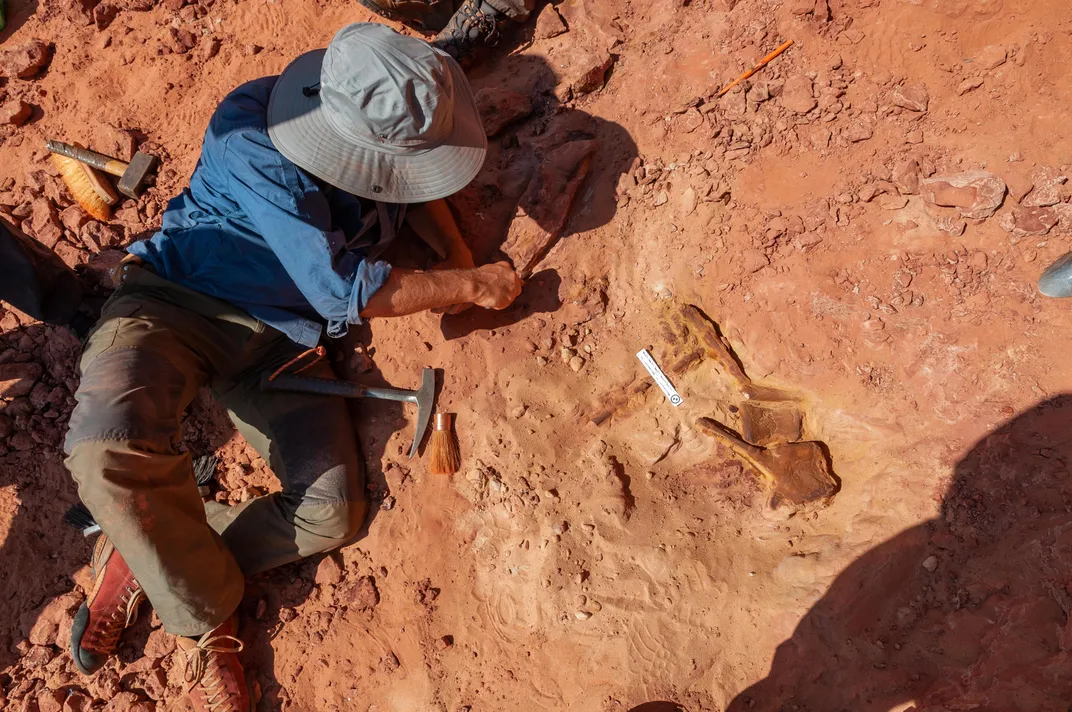Groundbreaking Fossil Suggests Spinosaurus Is First Known Swimming Dinosaur
Its paddle-like tail, unearthed in Morocco, suggests the Cretaceous carnivore ventured into the water to hunt
/https://tf-cmsv2-smithsonianmag-media.s3.amazonaws.com/filer/e8/3c/e83c4ecf-2158-4f55-ae2d-6b1f2dcfed94/image_one.jpeg)
When Munich's Paleontological Museum was bombed in 1944, the institution's collections were destroyed. Included in the wreckage was the only known partial skeleton of Spinosaurus aegyptiacus, a peculiar dinosaur that would later ignite an intense debate among paleontologists. The fossilized bits, first discovered in Egypt in the early 1910s, seemed to challenge the idea that all dinosaurs were strictly land-dwellers. Sporting a mix of odd features, including a skull that hinted at a fish-based diet, Spinosaurus may have spent some of its time swimming in open water.
In the decades since, a smattering of other Spinosaurus remains—all sparse and incomplete—have been found, fueling debate on both sides. Dinosaurs are considered, after all, to be complete landlubbers. Most Mesozoic-Era ocean-dwelling creatures were actually marine reptiles called plesiosaurs, ichthyosaurs, or mosasaurs, which, despite their appearance, are not considered dinosaurs. Claims of an exception demanded extraordinary evidence.
Now, a striking find from Morocco may finally be putting the matter to bed. Reporting this week in the journal Nature, a team of researchers has uncovered a 95-million-year old Spinosaurus tail with an unusual paddle shape. Structured like a thick, bony oar that could have rocked from side to side, the two-foot-long appendage is unmistakably aquatic, researchers argue, and likely propelled the gargantuan dinosaur through the water depths of rivers, where it snared and snacked on fish.
“This was basically a dinosaur trying to build a fish tail,” study author Nizar Ibrahim, a vertebrate paleontologist at University of Detroit Mercy, tells Michael Greshko at National Geographic.

The discovery bucks years of speculation that Spinosaurus simply dabbled in watery activities, wading into the shallows to hunt before quickly retreating back ashore. It also represents one of the most unusual traits ever attributed to a large, predatory dinosaur, Matthew Lamanna, a vertebrate paleontologist at the Carnegie Museum of Natural History in Pittsburgh, who reviewed the paper for Nature, tells Carolyn Gramling at Science News.
“The tail was just so awesomely weird-looking," Lamanna tells Science News. "I’d never seen anything like it.”
For Ibrahim and his team, the finding was less of a surprise. Several years ago, they analyzed a set of Spinosaurus bones, found in Morocco in 2008, that seemed to have unusually thick walls, a feature that helps animals like penguins and manatees control how buoyant they are in water. The researchers argued—controversially—that the dinosaur might have been more dexterous in the water than its distant, land-dwelling relatives like Tyrannosaurus rex. Though some, like Lindsay Zanno, a paleontologist at the North Carolina Museum of Natural Sciences, praised the findings at the time, others pushed back, according to National Geographic.
So Ibrahim and his colleagues returned to the site of the 2008 fossil. In 2018, they “struck gold,” unearthing a tail that was nearly 80 percent complete, Ibrahim tells Science News. Bristling with long spines that branched out into a fin shape, the tail was wide, strong and flexible, modeling studies suggested. Unlike the long, narrowing tails of land-living dinosaurs, Spinosaurus’ rearmost appendage seemed built to whip back and forth like that of a crocodile or a newt—a theory that seemed borne out when the researchers modeled its motion in a water tank.

If Spinosaurus truly was the sort of swimmer its tail suggests it was, paleontologists may need to rework their definitions of dinosaurs—a group whose members must lay their eggs on land, and have traditionally been thought of as terrestrial, Ryan F. Mandelbaum reports for Gizmodo.
But boundaries have been broken on the tree of life before, points out Thomas Holtz, a vertebrate paleontologist at the University of Maryland in College Park who was not involved in the study, in an interview with Science News: “We think of mammals as a terrestrial group, but we have whales and bats.”
Speaking with Gizmodo, Steven Brusatte, a paleontologist from the University of Edinburgh who wasn’t involved in the study, notes that Spinosaurus’ fishy tail wouldn’t have precluded it from making a living on land, too—at least some of the time. “Its fossils are also found inland,” he says, “so it probably was comfortable on land and in water.”
And when it did venture out for a swim, Spinosaurus probably stuck to the shallows, keeping within a safe distance of the shore, Brusatte notes. But in dipping its toes—and its tail—in the water at all, this versatile dinosaur may still have made quite the evolutionary splash.
/https://tf-cmsv2-smithsonianmag-media.s3.amazonaws.com/accounts/headshot/10172852_10152012979290896_320129237_n.jpg)
/https://tf-cmsv2-smithsonianmag-media.s3.amazonaws.com/accounts/headshot/10172852_10152012979290896_320129237_n.jpg)